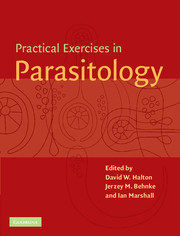Book contents
- Frontmatter
- Contents
- List of contributors
- Preface
- General advice
- 1 Observational Exercises on Parasites
- 2 Ecology
- 3 Physiology and Biochemistry
- 3.1 Hatching in vitro of oncospheres/hexacanth larvae of Hymenolepis diminuta
- 3.2 Activation of the cysticercoids of Hymenolepis species in vitro
- 3.3 Membrane transport in the cestode Hymenolepis diminuta, in vitro
- 3.4 Glycogen utilisation and deposition in flatworm parasites
- 3.5 Effects of classical transmitters on the motility of parasitic roundworms and flatworms
- 3.6 Electrophysiology of Ascaris suum body muscle
- 3.7 Immunocytochemical localisation of neuroactive substances in helminth parasites
- 4 Pathology and Immunology
- 5 Chemotherapy
- 6 Molecular Parasitology
- 7 Behaviour
- Appendix 1 Reagent index
- Appendix 2 UK suppliers
- Appendix 3 US suppliers
- Index
3.2 - Activation of the cysticercoids of Hymenolepis species in vitro
Published online by Cambridge University Press: 05 June 2012
- Frontmatter
- Contents
- List of contributors
- Preface
- General advice
- 1 Observational Exercises on Parasites
- 2 Ecology
- 3 Physiology and Biochemistry
- 3.1 Hatching in vitro of oncospheres/hexacanth larvae of Hymenolepis diminuta
- 3.2 Activation of the cysticercoids of Hymenolepis species in vitro
- 3.3 Membrane transport in the cestode Hymenolepis diminuta, in vitro
- 3.4 Glycogen utilisation and deposition in flatworm parasites
- 3.5 Effects of classical transmitters on the motility of parasitic roundworms and flatworms
- 3.6 Electrophysiology of Ascaris suum body muscle
- 3.7 Immunocytochemical localisation of neuroactive substances in helminth parasites
- 4 Pathology and Immunology
- 5 Chemotherapy
- 6 Molecular Parasitology
- 7 Behaviour
- Appendix 1 Reagent index
- Appendix 2 UK suppliers
- Appendix 3 US suppliers
- Index
Summary
Aims and objectives
This exercise is designed to demonstrate:
The importance of various factors in the activation and excystation of the cysticercoids.
Changes in the appearance of the cysticercoids during excystation
The behaviour of freshly excysted larvae.
Introduction
Many parasites use more than a single host species during the course of their life cycle. Often the larval stages develop in one host and the adults in another. Thus, the parasite must be transmitted from one host to the next in order to complete development. The most common relationship between hosts exploited by parasites for transmission, particularly those living in the intestine as adults, is that involved in the predator-prey food chain. For example, some tapeworms develop as larvae in small flour beetles, Tribolium confusum, but parasitise rodents such as mice and rats as adults. Rodents are essentially grain feeders, but will consume insects also and therefore by depending on two host species, both of which have habitats closely associated with cereals and grain, the tapeworms ensure that their transmission cycle is completed successfully.
This practical is based on two species of tapeworm, Hymenolepis diminuta and Rodentolepis microstoma (formerly known as H. microstoma; see Exercise 1.14). The former develops successfully to the adult stage in the rat only (Fig. 3.2.1), the latter matures in mice. Both utilise the flour beetle, Tribolium confusum, as the intermediate host.
The larval (metacestode) stage developing in beetles is called a cysticercoid.
- Type
- Chapter
- Information
- Practical Exercises in Parasitology , pp. 183 - 190Publisher: Cambridge University PressPrint publication year: 2001
- 1
- Cited by



